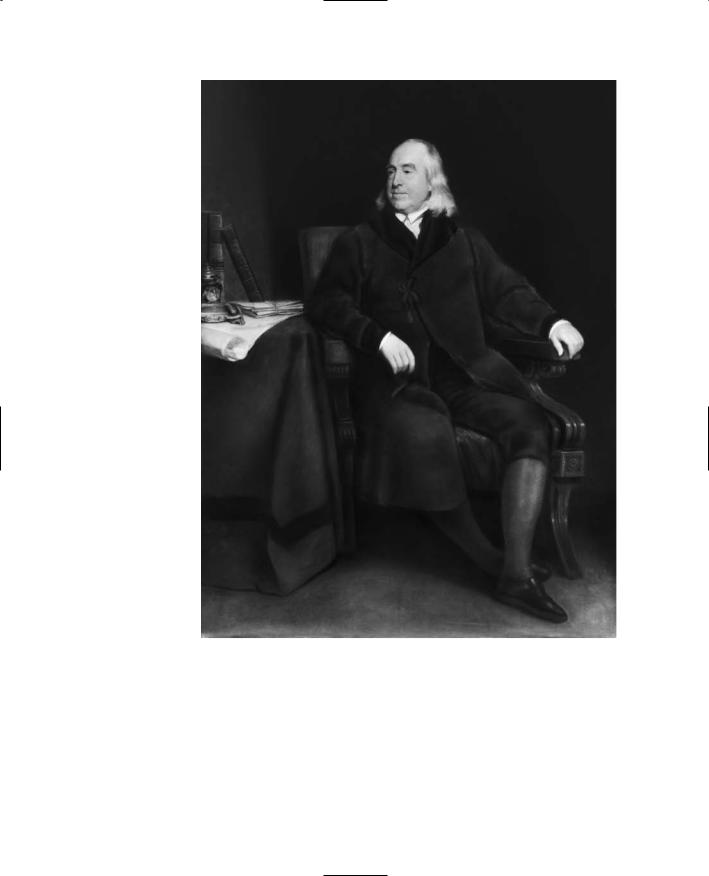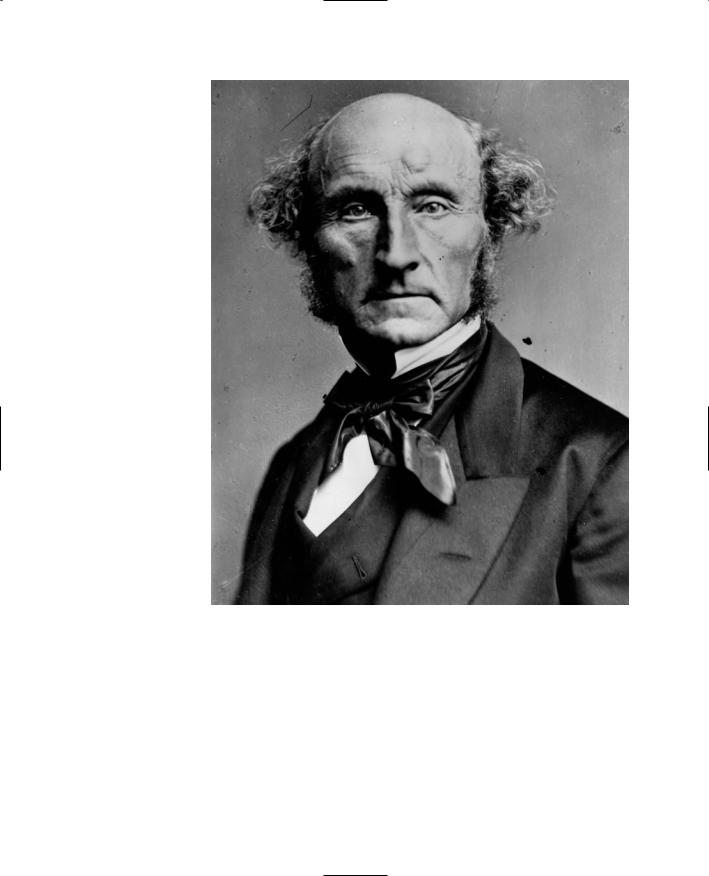
Liberalism
.pdf
CHAPTER 3 Liberalism |
65 |
for instance, led Prussia (later part of Germany) to undertake many reforms, including the abolition of serfdom.
On the European continent, however, Napoleon’s defeat at Waterloo in 1815 marked the beginning of thirty years of reaction against these revolutionary changes. Monarchs and aristocrats reasserted their hereditary rights. Ironically, the country most responsible for Napoleon’s defeat, England, was also the country in which liberalism had made its greatest gains.
At the beginning of the 1800s, the British Empire was still expanding. The thirteen American colonies had gained their independence, but Britain continued to control India, Canada, and Australia, and it was soon to acquire vast territories in Africa as well. The Industrial Revolution was also making England the world’s first great industrial power. Beginning about 1750, the invention of new machinery, the discovery of steam power, and the development of assembly lines and other mass-production techniques brought about a remarkable increase in productive power. English merchants thus were able to import raw materials, such as cotton, and to manufacture goods to be sold at home and abroad for handsome profits. With its combination of empire and industry, Great Britain became “the workshop of the world”—and the world’s greatest imperial power—in the nineteenth century.
But power comes at a price, and in Britain the price was a society more sharply divided along class lines. Although the landed aristocracy was still the dominant force in the early 1800s, middle-class merchants and professionals made enormous political and economic gains during the first half of the century. The same cannot be said of the men, women, and children of the working class. Poor and numerous, they toiled in the mines, mills, and factories that sprang up during the Industrial Revolution, and their situation was bleak indeed. Without unemployment compensation, or regulation of working hours or safety conditions, or the legal right to form trade or labor unions, they worked under extremely harsh and insecure conditions. Just how harsh is suggested by a bill proposed in Parliament early in the century to improve the workers’ position. The bill forbade factories to employ children under the age of ten, to put anyone under eighteen on night work (i.e., 9 P.M. through 5 A.M.), or to require anyone under eighteen to work more than ten and one-half hours a day. Even this bill did not pass until, after years of debate, it had been so weakened as to be ineffective.15
In economic status and in political power, too, the working class fell far behind the middle class in the first half of the nineteenth century. The Reform Bill of 1832 lowered property qualifications enough to give middle-class males the right to vote, but most adult males and all women were still denied suffrage. This situation was a matter of some concern to the leading liberal writers of the day, a group known then as the Philosophic Radicals and later as the Utilitarians.
Utilitarianism
Jeremy Bentham. The original leader of the Utilitarians (or Philosophic Radicals) was the English philosopher Jeremy Bentham (1748–1832). Society must be made more rational, he insisted, and the first step in this direction is to recognize that people act out of self-interest. Moreover, everyone has an interest in experiencing pleasure and avoiding pain. As Bentham put it, “Nature has placed mankind under the governance

66 |
PART TWO The Development of Political Ideologies |
Jeremy Bentham (1748–1832)
of two sovereign masters, pain and pleasure. It is for them alone to point out what we ought to do, as well as to determine what we shall do.”16 This is simply a fact of human nature, he thought, and there is nothing we can do to change it. But once we understand that all people seek pleasure and avoid pain in everything they do, we can take steps to be better pleasure-seekers and pain-avoiders.
Bentham did not mean that we should seek pleasure in immediate gratification— in getting drunk, for example—because the pain we or others suffer later will probably outweigh the short-term pleasure. He meant, rather, that we should seek utility.

CHAPTER 3 Liberalism |
67 |
Something has utility—a hammer for a carpenter, for instance, or money for almost everyone—if it helps someone do what he or she wants. Because people want to be happy, utility promotes happiness.
Bentham recognized that people will sometimes fail to see what does and does not have utility for them—someone who drops out of school may not appreciate the utility of education, for example. He also admitted that, in pursuing our own pleasures, we may bring pain to others. But the purpose of government is to solve these problems. In Bentham’s words, “The business of government is to promote the happiness of society, by punishing and rewarding.”17 By punishing those who cause pain to others and by rewarding those who give pleasure, in other words, government can and should act to promote the greatest happiness of the greatest number.
From this Bentham drew two general conclusions about government. The first was that government could generally promote the greatest happiness of the greatest number simply by leaving people alone. Individuals are usually the best judges of their own interests, so government should usually let people act as they see fit. For this reason Bentham accepted the laissez-faire arguments of Adam Smith. His second conclusion was that government is not likely to promote the greatest happiness of the greatest number if it is controlled by a small segment of society. In the pursuit of utility, Bentham declared, everyone is to count equally. Government must weigh everyone’s interests, and this requires that almost everyone be allowed to vote. Although Bentham’s views on voting are not altogether clear, he did support universal male suffrage and, with certain reservations, the vote for women as well.18
John Stuart Mill. The views of John Stuart Mill (1806–1873) on this matter are not in doubt, for Mill was an ardent advocate of women’s rights. An influential Utilitarian, Mill was the leading liberal philosopher of the nineteenth century. Whether supporting women’s rights or arguing that government should set minimum educational standards for all, Mill’s greatest concern was to defend and extend individual liberty. This concern is most evident in his essay On Liberty.
When Mill published On Liberty in 1859, liberalism seemed to have triumphed, at least in England and the United States. The old enemies—ascribed status, religious conformity, and absolute government—were no longer the obstacles to individual liberty they once had been. Yet Mill was alarmed by what he took to be a new threat to liberty in the growing power of public opinion. In the old days, Mill said, the chief enemy of freedom was the government; but now that we elect representatives, the government is more responsive to the desires of the people. It is responsive, however, to the majority of the people, or at least the majority of those who vote, and this allows them to use the government to restrict or take away the liberty of those who do not share the majority’s views. Moreover, the majority can bring social pressure to bear on those who do not conform to the ordinary, conventional ways of life. Without going through the government or the law, the “moral coercion of public opinion” can stifle freedom of thought and action by making social outcasts of individuals who do not conform to social customs and conventional beliefs. Like Alexis de Tocqueville, whose Democracy in America he greatly admired, Mill was worried about “the tyranny of the majority.”
On Liberty was Mill’s attempt to deal with this new form of tyranny. There he advanced “one very simple principle”: “The only purpose for which power can be

68 |
PART TWO The Development of Political Ideologies |
John Stuart Mill (1806–1873)
rightfully exercised over any member of a civilized community, against his will, is to prevent harm to others. His own good, either physical or moral, is not a sufficient warrant.”19 According to this principle—sometimes called the harm principle—every sane adult should be free to do whatever he or she wants so long as his or her actions do not harm or threaten to harm others. Government and society, then, should not interfere with an individual’s activities unless that individual is somehow harming or threatening to harm others. Government has no business prohibiting the sale of alcohol, for instance, on the grounds that drinking harms the drinker; but government should certainly prohibit drunken driving on the grounds that this poses a serious threat of harm to others.

CHAPTER 3 Liberalism |
69 |
In formulating the harm principle Mill in effect formalizes an idea expressed by Thomas Jefferson some 75 years earlier. “The legitimate powers of government,” Jefferson wrote, “extend to such acts only as are injurious to others. But it does me no injury for my neighbor to say there are twenty gods, or no god. It neither picks my pocket nor breaks my leg.”20 I might find my neighbor’s opinion offensive or upsetting; but unless its expression causes demonstrable harm to me or to someone else, government has no legitimate role in outlawing its expression, however offended or upset some people might be.
Mill defended his principle by appealing not to natural rights, as most of the early liberals had done, but to utility. Freedom is a good thing, he argued, because it promotes “the permanent interests of man as a progressive being.” By this he meant that both individuals and society as a whole will benefit if people are encouraged to think and act freely. For the individual, freedom is vital to personal development. Our mental and moral faculties are like muscles, Mill said. Without regular and rigorous exercise, they will weaken and shrivel. But people cannot exercise their minds and their powers of judgment when they are constantly told what they can and cannot do. To be fully human, then, individuals must be free to think and speak for themselves—as long as they neither harm nor threaten harm to others.
It is possible, of course, that people who speak and act freely will make others, perhaps even the majority of society, uncomfortable and unhappy. But in the long run, Mill argued, the ideas of nonconformists such as Socrates, Jesus, and Galileo work to the benefit of society. Progress is possible only when there is open competition between different ideas, opinions, and beliefs. As in economics, a free marketplace of competing ideas yields a greater variety to choose from and allows people to distinguish good ideas from bad. Without freedom of thought and action, society will remain stuck in the rut of conformity and will never progress.
Mill’s desire to promote individual liberty also led him to recommend representative democracy as the best possible form of government. In Considerations on Representative Government (1861) he maintained that political participation is one of the best forms of exercise for the mental and moral faculties. Only in a democracy, he argued, is this kind of exercise available to all citizens. In this respect Mill’s argument for democracy differed from Bentham’s, who thought that democracy is valuable as a means of protecting individuals’ material interests. That is, in so far as everyone has an equal vote in a democracy, then every voter has an equal say when voting for or against proposed policies or candidates for office—an equal say that Bentham believed that voters would use to protect their personal interests. Mill agreed that “selfprotection” is a valuable feature of democracy, but he held that “self-development” is even more valuable, as democratic participation can promote the civic education of citizens by broadening their horizons and sympathies through discussion, debate, and public service, such as jury duty. In this way Mill stressed the educative rather than the protective value of democracy.21 Even so, Mill’s fear of “the tyranny of the majority” kept him from embracing democracy wholeheartedly. Among other things, he favored a form of plural voting in which every literate man and woman will have a vote, but some—those with higher levels of education, for instance—will have two, three, or more. Plural voting thus would enable everyone to enjoy the benefits of political participation, yet allow more enlightened and better-informed citizens to protect individual liberty. Such a system was necessary, Mill believed, at least until the overall level of education was high enough to remove the threat of majority tyranny.

70 |
PART TWO The Development of Political Ideologies |
As for economic matters, Mill began his career as a staunch defender of laissezfaire capitalism. Toward the end of his life, however, he called himself a socialist. This shift in his thinking was one of the first signs of an even greater shift on the part of many liberals in the latter part of the nineteenth century—a shift that divided liberalism into rival camps.
LIBERALISM DIVIDED
The division among liberals stemmed from their different reactions to the social effects of the Industrial Revolution. The misery of much of the English working class became increasingly obvious, in part through the depiction of their plight in the popular novels of Charles Dickens. Reform movements were under way, and socialism was gaining support, especially on the European continent. Some liberals began to argue that government should rescue people from poverty, ignorance, and illness. Because of their concern for the well-being, or “well-faring,” of the individual, this group has come to be called welfare or welfare-state liberals. Other liberals maintained that any steps of this sort would invest too much power in the government, which they continued to regard as a necessary evil and one of the main obstacles to individual liberty. Because their position is so close to that of early liberalism, it has come to be called neoclassical (or “new classical”) liberalism.
Neoclassical Liberalism
Since the second half of the nineteenth century, neoclassical liberals have consistently argued that government should be as small as possible in order to leave room for the exercise of individual freedom. The state or government should be nothing more than a “nightwatchman” whose only legitimate business is to protect the person and property of individuals against force and fraud. Some neoclassical liberals have based this argument on an appeal to natural rights, others on an appeal to utility. In the late 1800s, however, the most influential among them based their arguments on Darwin’s theory of evolution.
In his Origin of Species (1859), Charles Darwin used the idea of “natural selection” to account for the evolution of life-forms. Darwin held that individual creatures within every species experience random mutations, or accidental changes, in their biological makeup. Some mutations enhance a creature’s ability to find food and survive, while others do not. Those lucky enough to have beneficial mutations are more likely to survive—and to pass these biological changes along to their offspring—than less fortunate members of their species. Thus nature “selected” certain creatures with certain mutations and thereby “directed” the path of evolution. But all this was accidental and unintentional. This biological good fortune also gives the members of some species an adaptive advantage over others in competition for food—for instance, giraffes are able to eat the leaves on the higher branches of trees, which is a distinct advantage when food is scarce. Mutations thus account not only for the evolution of species, but also for their survival or extinction.
Although Darwin did not derive any social and political implications from his theory, others were quick to do so. Many who had stressed the importance of economic competition seized upon Darwin’s theory of natural selection as “proof” that the

CHAPTER 3 Liberalism |
71 |
struggle for survival was natural to human life and that government should not “interfere” in that struggle. Two of the most important of these Social Darwinists were Herbert Spencer and William Graham Sumner.
Social Darwinism. Herbert Spencer (1820–1903), an English philosopher, had begun to think in evolutionary terms before Darwin’s Origin of Species appeared, and he took Darwin’s work to confirm the main lines of his own thought. In particular, Spencer claimed that there is a natural struggle for survival within the human species. Nature means for individuals to be free to compete with one another. Those who are strongest, smartest, and most fit for this competition will succeed and prosper; those who are unfit will fail and suffer. But this is simply nature’s way, Spencer said. Helping the poor and the weak impedes individual freedom and retards social progress by holding back the strong. Indeed, it was Spencer who coined the phrase, “survival of the fittest.” Such views made Spencer a leading advocate of the “nightwatchman state.”
William Graham Sumner (1840–1910) was the leading American advocate of Social Darwinism. A professor of sociology at Yale University, Sumner proclaimed that “there are two chief things with which government has to deal. They are, the property of men and the honor of women.”22 These are the only matters with which government should concern itself. In the competition for survival, government should simply see to it that everyone competes fairly and freely. “Freedom,” for Sumner, meant the freedom to compete, including the freedom of the victors to keep and enjoy the fruits of their victory without having to share them with anyone else—certainly not with the poor, who were poor precisely because they had lost in this life-and-death competition. In fact, Sumner and the Social Darwinists insisted that neither government nor even private charity should try to help anyone, no matter how weak or desperate he or she might be, except by providing protection against force and fraud. As Sumner put it, “A drunkard in the gutter is just where he ought to be, according to the fitness and tendency of things. Nature has set up on him the process of decline and dissolution by which she removes things which have [outlived] their usefulness.”23
Most neoclassical liberals have not been as extreme in their views as the Social Darwinists; few neoclassical liberals today base their arguments on evolutionary premises. But in the latter part of the nineteenth century, the Social Darwinists were quite influential in England and the United States, especially among businessmen who sought scientific support for laissez-faire capitalism.
Welfare Liberalism
Like classical and neoclassical liberals, welfare liberals believe in the value of individual liberty. But welfare liberals maintain that government is not just a necessary evil. On the contrary, properly directed, government can be a positive force for promoting individual liberty by ensuring that everyone enjoys an equal opportunity in life.
T. H. Green. One of the first to make the case for welfare liberalism was T. H. Green (1836–1882), a professor of philosophy at Oxford University. The heart of liberalism, Green said, has always been the desire to remove obstacles that block the free growth and development of individuals. In the past that meant limiting the powers

72 |
PART TWO The Development of Political Ideologies |
of government so that people can be free to live, worship, and compete in the marketplace as they see fit. By the mid-1800s these aims had largely been accomplished in countries like England, and it was time to recognize and overcome still other obstacles to freedom and opportunity—obstacles such as poverty and illness, prejudice and ignorance. To overcome these obstacles, Green argued, it was necessary to enlist the power of the state.
Green based his argument on a distinction between two different ways of thinking about freedom, ways that he called negative and positive freedom. The early liberals regarded freedom as a negative thing, he said, for they thought of freedom as the absence of restraint. Someone who was restrained—tied up and locked in jail, for instance—was not free, while someone who was unrestrained was. But Green believed that there is more to freedom than this. Freedom is not merely a matter of being left alone; it is the positive power or ability to do something. Thus we may say that a child born into poverty, with no real opportunity to escape, is not truly free to grow and develop to the full extent of his or her abilities. Even if no one is intentionally restraining that child by keeping him or her in poverty, the child is still not free. But if we admit this, Green argued, anyone who values individual liberty will want to take steps to overcome those circumstances that are such formidable obstacles to freedom.24
Green and other welfare liberals believed that society, acting through government, should establish public schools and hospitals, aid the needy, and regulate working conditions to promote workers’ health and well-being. Only through such public support would the poor and powerless members of society become truly free. Neoclassical liberals complained that these policies simply robbed some individuals of their freedom by forcing them to transfer their property, through taxes, to others. Green responded that everyone gained freedom when he or she served the common good. For positive freedom is the ability to realize or achieve our ideal or “higher” selves in cooperation with others. Human beings are not merely pleasure-seekers and painavoiders. We have higher ideals, including ideals of what we can and ought to be as persons. The laws and programs that help the unfortunate, smooth social relations, and restrict all-out competition are positive aids to liberty, not restraints that limit our freedom. They may restrict our selfish or “lower” selves, but laws and programs of this sort encourage our “higher” selves to realize our nobler and more generous ideals through social cooperation.25
In the late nineteenth and early twentieth centuries, many scholars and political figures adopted views similar to Green’s. These other welfare liberals saw an active government as a useful, even necessary tool in the campaign to expand individual liberty. Like Green, they also insisted that human beings are social creatures, not isolated individuals who owe nothing to anyone else. Gradually their ideas and arguments prevailed among liberals. By the middle of the twentieth century, in fact, welfare liberals were usually known simply as “liberals,” while their neoclassical rivals were often called “conservatives”—a piece of terminological confusion that we shall try to clarify in Chapter 4.
The Welfare State. As we shall see in later chapters, socialists also advanced schemes for social reform. But it is important to distinguish welfare or welfare-state liberalism from socialism. Socialists want to do more than tame or reform capitalism; they want to replace it with a system of publicly owned and democratically controlled

CHAPTER 3 Liberalism |
73 |
enterprises. Welfare liberals, by contrast, prefer private ownership and generally take a competitive capitalist system for granted. From the perspective of the welfare liberal, the role of government is to regulate economic competition in order to cure the social ills and redress individual injuries wrought by capitalist competition. Unlike socialists, in short, welfare liberals regard economic competition as a good thing— but only up to the point where it comes at the expense of individual welfare.
It is also important to note that the grandfather of the modern welfare state was neither a socialist nor a liberal of any sort. Otto von Bismarck (1815–1898), the staunchly conservative and ardently antisocialist “Iron Chancellor” who united Germany in the latter part of the nineteenth century, believed that the welfare state was the best way to oppose socialism. Through a state-sponsored system of taxing employers and employees to support ill, injured, and unemployed workers, the German state stole the thunder of the socialists, who had played upon the anxieties of workers subject to the up-and-down cycles of a capitalist economy.
The birth of the welfare state also coincided roughly with the expansion of voting rights throughout much of Europe. In England the reforms of 1867 and 1885 brought the franchise to almost all adult males and thus made the working class a more powerful political force. The political representatives of this class contributed not only to the growth of the welfare state but also to the prominence of welfare liberalism in the twentieth century.26
LIBERALISM IN THE TWENTIETH CENTURY
Another factor also contributed to the dominance of welfare over neoclassical liberalism. By the beginning of the 1900s, capitalist competition looked quite different from what it had been a century before. In the industrialized world the lone entrepreneur who ran his or her own business had largely given way to the corporation, the trust, the syndicate, and the conglomerate. Business was now “big business,” and many people began to call for government intervention in the marketplace, not to restrict competition, but to keep the large corporations from stifling it.
Historical Developments
In one form or another, however, the neoclassical liberals’ faith in individual competition and achievement survived into the twentieth century, most notably in the United States. This faith was severely tested by the Great Depression of the 1930s. Individuals, no matter how rugged, seemed no match for this devastating economic collapse. The effects, political as well as economic, were felt throughout the world, as ideologues of every stripe sought to explain and exploit the situation. Many blamed the Depression on capitalism and turned either to socialism or communism, on the one hand, or to fascism, on the other. In the English-speaking countries, by contrast, the main response was to turn to the welfare state.
The liberal case for active government gained further support from the theory advanced by the English economist John Maynard Keynes (1883–1946). In his
General Theory of Employment, Interest and Money (1936), Keynes argued that governments should use their taxing and spending powers to prevent depressions and maintain a healthy economy. Put simply, Keynes’s theory holds that governments

74 |
PART TWO The Development of Political Ideologies |
should try to manage or “fine-tune” the economy. When prices are rising, the government should raise taxes to reduce consumer spending and prevent inflation. When inflation is no longer a threat, government should lower taxes, increase spending on social programs, or both, in order to stimulate the economy and maintain high levels of employment. Whatever the strategy at any particular time, Keynes’s approach calls for active government management of economic matters—an approach welcomed by welfare liberals and now practiced by all advanced capitalist countries, including the United States.
Such governmental regulation of the economy began in earnest during the Great Depression of the 1930s. President Franklin D. Roosevelt’s New Deal regulated financial markets, banks, and other economic institutions, protected depositors from bank failures, provided public sector employment for unemployed Americans, and stimulated the economy by “priming the pump” with government spending on public works and other projects. Conservative critics cried “socialism” and “wasteful spending,” but Roosevelt replied that he was saving capitalism from its own excesses and that, in any case, massive expenditures for infrastructure—roads, bridges, dams that prevented floods and produced hydroelectric power, and the like—not only alleviated suffering in the present but was actually a form of investment that would pay large dividends in the future.
The even more massive expenditures of World War II brought an end to the Depression, but the welfare state remained. Welfare liberalism became the dominant ideology of the Western world. Welfare liberals usually reached some sort of accommodation with their socialist and conservative rivals, as most parties accepted the desirability of the welfare state. Indeed, this consensus seemed so broad and firm that some political observers began to speak in the late 1950s of “the end of ideology.” That hope was soon dashed in the political turmoil of the 1960s and early 1970s and the resurgent conservatism of the 1980s.
For one thing, there were controversies within liberalism. In the United States, Martin Luther King, Jr., and other leaders of the civil rights movement pointed out that liberal promises of liberty and equality were still unfulfilled for African-Americans. This was a painful truth that all liberals had to acknowledge, however reluctantly. When King and others protested against the segregation laws that made black people second-class citizens, neoclassical and welfare liberals alike could join in support. But King went on to call for government action not only to eliminate legal discrimination against African-Americans and other minorities but also to provide social and economic opportunities.27 This was acceptable to welfare liberals, but not to their neoclassical cousins. The neoclassical wing formed a distinct minority among liberals, however, as their losing battle against President Lyndon Johnson’s “Great Society” programs of the 1960s testifies. These programs, which sought to end discrimination against racial minorities, to fight a “War on Poverty,” and to use the powers of government to provide equality of opportunity, sprang from the welfare liberals’ belief that government can and should be used to foster individual liberty.
The turmoil of the 1960s also presented another challenge to welfare liberalism— the New Left. Vaguely socialist in its orientation, the New Left rejected both the “obsolete communism” of the Soviet Union and the “consumer capitalism” of the liberal democracies. Most New Leftists accepted the liberal emphasis on individual rights and liberties, and most also supported government programs to promote
